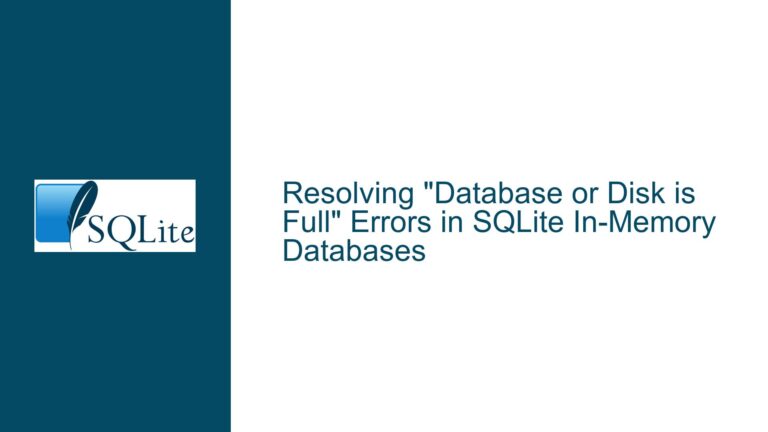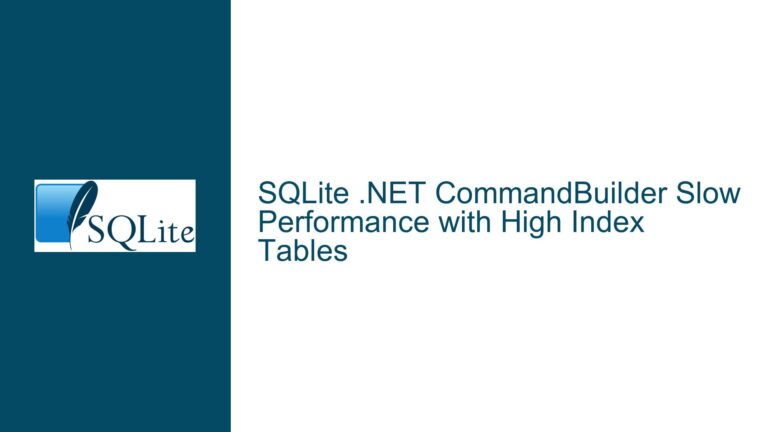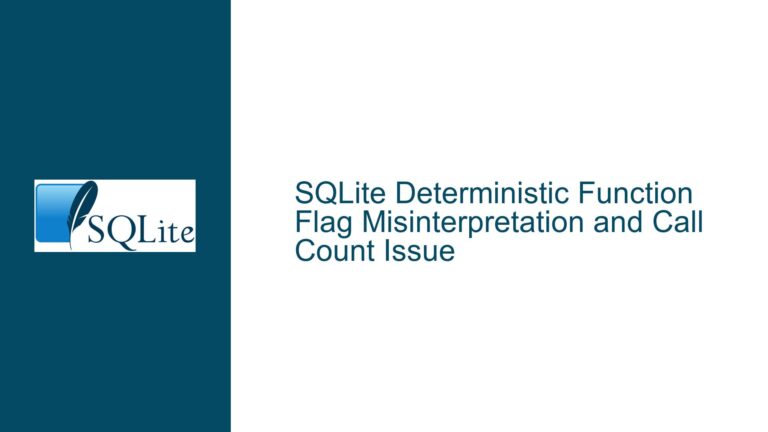SQLite Partial Index Usage and Query Optimization
Issue Overview: SQLite Partial Index Matching and Query Optimization
In SQLite, partial indexes are a powerful feature that allows developers to create indexes on a subset of rows in a table, based on a specified condition. This can significantly improve query performance and reduce storage overhead by indexing only the relevant rows. However, the effectiveness of partial indexes is highly dependent on the query’s WHERE clause matching the index’s condition exactly. SQLite does not perform algebraic transformations or logical inferences to determine if a query’s condition implies the index’s condition. This behavior can lead to situations where a query that logically should use a partial index does not, resulting in suboptimal query performance.
Consider the following example:
CREATE TABLE foo(x INT);
INSERT INTO foo(x) VALUES(42);
CREATE INDEX bar ON foo(x) WHERE x > 0;
In this setup, a partial index bar is created on the foo table, indexing only those rows where x > 0. Now, consider the following query:
EXPLAIN QUERY PLAN SELECT * FROM foo WHERE x > 0 AND x > 1;
In this query, the condition x > 1 logically implies x > 0. However, SQLite does not infer this relationship. As a result, if the query does not explicitly include the condition x > 0, the partial index bar will not be considered usable by the query optimizer. This behavior is explicitly documented in the SQLite documentation, which states that SQLite does not have a sophisticated theorem prover to determine logical implications between conditions.
The core issue here is that SQLite requires the terms in the query’s WHERE clause to match the terms in the partial index’s condition exactly. This means that even if a query’s condition logically implies the index’s condition, SQLite will not use the partial index unless the query explicitly includes the index’s condition. This can lead to confusion and suboptimal query performance, especially for developers who are accustomed to databases that perform more advanced query optimization.
Possible Causes: Why SQLite Does Not Infer Logical Implications
The primary reason SQLite does not infer logical implications between conditions in a query and a partial index is due to its design philosophy. SQLite is designed to be a lightweight, embedded database engine with a minimal footprint. As such, it avoids complex and computationally expensive operations, such as algebraic transformations and logical inference, which are typically found in more sophisticated database systems.
SQLite’s query optimizer is designed to be fast and efficient, with a focus on simplicity and predictability. This means that it relies on straightforward matching of terms between the query’s WHERE clause and the index’s condition. While this approach is less powerful than the optimizers found in larger database systems, it is consistent with SQLite’s goal of being a lightweight and easy-to-use database engine.
Another factor contributing to this behavior is the lack of a sophisticated theorem prover in SQLite. A theorem prover is a component that can determine logical relationships between expressions, such as whether one condition implies another. Without such a component, SQLite cannot infer that a condition like x > 1 implies x > 0. As a result, it requires explicit matching of terms to determine whether a partial index is usable.
This behavior is not unique to SQLite. Many lightweight database systems prioritize simplicity and performance over advanced optimization techniques. However, it is important for developers to be aware of this limitation when designing queries and indexes in SQLite, as it can have a significant impact on query performance.
Troubleshooting Steps, Solutions & Fixes: Ensuring Partial Index Usability in SQLite
To ensure that partial indexes are used effectively in SQLite, developers must carefully design their queries and indexes to match the conditions exactly. Here are some steps and solutions to address the issue of partial index usability:
Explicitly Include the Index Condition in the Query: The most straightforward solution is to ensure that the query’s WHERE clause includes the exact condition specified in the partial index. In the example above, this means including both
x > 0andx > 1in the query. While this may seem redundant, it ensures that SQLite recognizes the partial index as usable.EXPLAIN QUERY PLAN SELECT * FROM foo WHERE x > 0 AND x > 1;By including
x > 0in the query, SQLite will recognize that the partial indexbaris applicable, and the query optimizer will use it to improve performance.Avoid Overly Complex Index Conditions: When creating partial indexes, it is important to keep the conditions as simple as possible. Complex conditions can make it difficult for SQLite to match the query’s WHERE clause with the index’s condition. In the example above, the condition
x > 0is simple and straightforward, making it easy for SQLite to match.If the index condition were more complex, such as
x > 0 AND y < 10, it would be more challenging to ensure that the query’s WHERE clause matches the index’s condition exactly. In such cases, it may be necessary to simplify the index condition or break it into multiple indexes.Use Index Hints with Caution: SQLite allows developers to use the
INDEXED BYclause to force the query optimizer to use a specific index. However, this should be done with caution, as it can lead to suboptimal query plans if the index is not suitable for the query.In the example above, using
INDEXED BY barwithout includingx > 0in the query would result in a "no query solution" error, as SQLite would not recognize the partial index as usable. Therefore, it is important to ensure that the query’s WHERE clause matches the index’s condition before usingINDEXED BY.EXPLAIN QUERY PLAN SELECT * FROM foo INDEXED BY bar WHERE x > 0 AND x > 1;This query will use the partial index
barbecause the conditionx > 0is explicitly included.Consider Alternative Indexing Strategies: If the partial index’s condition is too restrictive or difficult to match in queries, it may be worth considering alternative indexing strategies. For example, a full index on the column
xcould be used instead of a partial index. While this would increase storage overhead, it would ensure that the index is usable for a wider range of queries.CREATE INDEX bar_full ON foo(x);With a full index, the query optimizer would be able to use the index for any query that involves the column
x, regardless of the specific conditions in the WHERE clause.Monitor Query Performance: It is important to monitor the performance of queries that use partial indexes to ensure that they are being used effectively. The
EXPLAIN QUERY PLANstatement can be used to analyze how SQLite is executing a query and whether it is using the expected indexes.EXPLAIN QUERY PLAN SELECT * FROM foo WHERE x > 0 AND x > 1;This statement will provide information about the query plan, including which indexes are being used. If the partial index is not being used as expected, it may be necessary to revisit the query or index design.
Understand SQLite’s Limitations: Finally, it is important to understand and accept the limitations of SQLite’s query optimizer. While SQLite is a powerful and versatile database engine, it is not designed to perform the same level of advanced optimization as larger database systems. By understanding these limitations, developers can design their queries and indexes in a way that works within SQLite’s constraints.
In conclusion, while SQLite’s partial indexes are a valuable tool for optimizing query performance, they require careful design and explicit matching of conditions to be used effectively. By following the steps and solutions outlined above, developers can ensure that their partial indexes are used as intended, leading to improved query performance and a more efficient database system.






